How To Clean Your Outdoor Projector Screen for Optimal Maintenance

What To Know
- Outdoor projector screens can withstand elements but should be cleaned with caution, avoiding moisture build-up that could damage the screen.
- Use mild soap and warm water for cleaning, apply gentle wipes without excessive pressure, and avoid harsh chemicals to preserve the screen’s reflective quality.
- For maintenance, clean outdoor screens regularly, particularly if they remain outdoors, to prevent mold and dirt accumulation, and never store them while they’re still wet.
In this guide, we’ll show you the essential steps to maintain and clean your outdoor projector screen, preventing damage and keeping your viewing experience spotless.
Let’s get started!
Quick Navigation
Can Outdoor Projector Screens Get Wet?
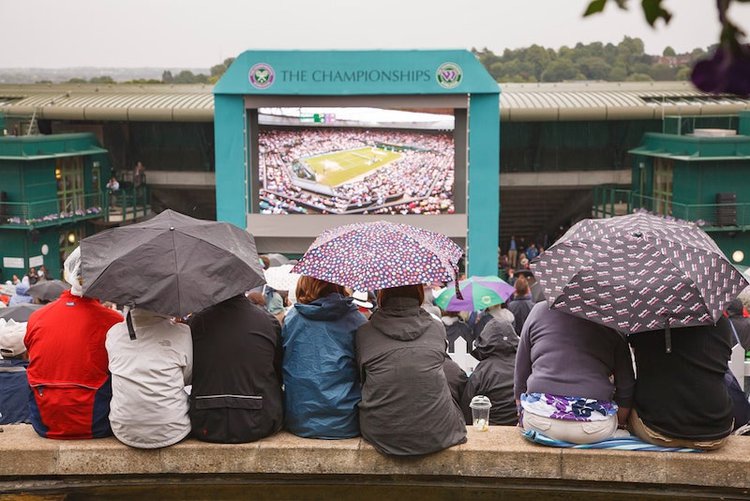
Outdoor projector screens are not supposed to get wet. If they do, repairing them could be a pain — particularly with no manufacturer warranty support in sight.
Outdoor projector screens can get wet in different ways. You don’t require rain or a splash of water to make the screen wet. Constant exposure to the moisture in the air could cause condensation issues in the screen, which would later emerge as patches, spots, etc.
The naked human eye may not be able to discern the moisture build-up during the initial stages of the precipitation. But, over a period, the accumulation would start to show face.
Not to mention, rain, snow, etc., won’t make your projector screen wet but would cause havoc of another kind. If your screen fell victim to bad weather, cleaning or repairing the screen may not be worth the effort and money — or it simply may not be possible.
Can You Wash an Outdoor Projection Screen?
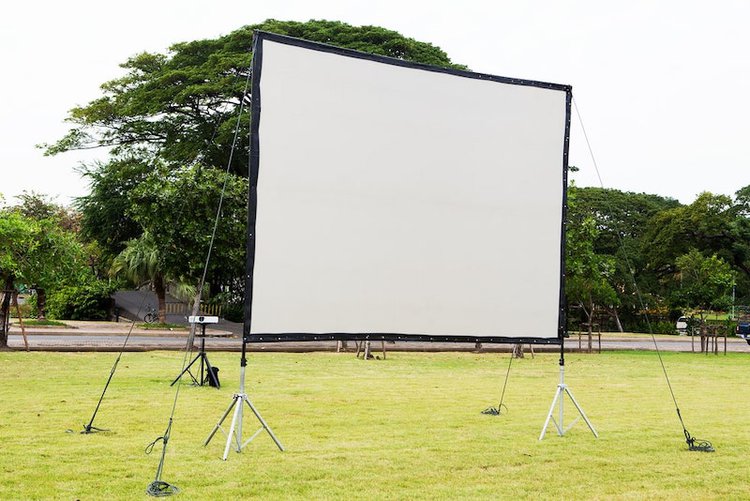
You can undoubtedly wash an outdoor projector screen — whether it’s rollable/collapsible or stiff. However, the cleaning approaches could vary based on the material, design, and rigidness of the screen.
Stain removal depends on the screen material and how long the screen has had the discoloration or blemish. If the projecting surface is essentially a wall (plain/textured), the cleaning requirements will differ from a collapsible/retractable screen’s needs.
But wall-based projection is typically employed indoors. For outdoor projection, screens made of polyester and cotton are most likely the choice. Cleaning those kinds of screens will be fittingly discussed here (a bit later).
How Often Should You Clean Your Outdoor Projection Screen?
Most projector screens are made of high-quality material built to withstand the elements.
Even budget-friendly screens are treated to last a fair bit — not permitting dirt and dust to stick to the screen and settle, for instance. The screens, therefore, can be cleaned once every few months.
However, with an outdoor projector screen, the time between two successive cleaning routines may have to be cut short to weeks.
And if the screen spends most of its time outdoors or you do not immediately roll the screen up and take it indoors after a movie or match, you may have to clean the screen a day or two before your next outdoor projection session.
What Can I Use to Clean My Outdoor Projector Screen?
- 32-fluid ounce bottle of first aid antiseptic
- First aid to help prevent risk of infection from minor cuts, scrapes and burns
- Active ingredient: 91% isopropyl alcohol
(Paid Link.)
Clean, slightly warmed water is all you need to wash an outdoor projector screen.
Dish soaps, mild detergents, environment-friendly soaps, etc., are things you could throw in for good measure — particularly when a more thorough cleaning exercise is needed.
Generally, clean water and/or some mild soap is good enough. You’ll be surprised to learn how efficiently your mild soap tackles those stubborn stains. If you’re not a fan of commercial cleaning products, use a water-vinegar mix instead.
Masking tape, microfiber towels/cloths (2 to 3 nos.), a pair of latex gloves, a few cotton swabs (Q-Tips ), and isopropyl alcohol (rubbing/denatured alcohol) — such as the Solimo 91% Isopropyl Alcohol — are other things you may need.
- The microfiber cloth helps dust the screen before the actual cleaning and also wipes off the clean, moist screen at the end.
- The latex gloves prevent natural oils from your fingers and palms from transferring over to the screen. The gloves also cover up your fingernails, so they don’t scratch the screen’s surface inadvertently.
- You can use cotton swabs to clean the tiny areas that may require individual attention.
- The masking tape helps treat a particular segment or area on the screen while insulating the adjoining areas. It’s, however, not essential, and you can very well do without it.
Additional tools to render the job easier include canned air (used instead of or alongside a microfiber cloth to blow off dirt and dust particles), foam brushes, and large pencil erasers.
No Harsh Chemicals
Steer clear of harsh cleaning agents, such as ammonia or bleach, as they could wear out the screen and the hard materials constituting the frame. Potent cleaning agents could hamper the screen’s ability to reflect visuals optimally.
If using bleach, make sure it’s highly diluted — a couple of drops of bleach for 8 ounces of water is right. If the bleach content is any greater, you could leave yellow spots/patches on a white screen.
How Do You Clean an Outdoor Projection Screen?
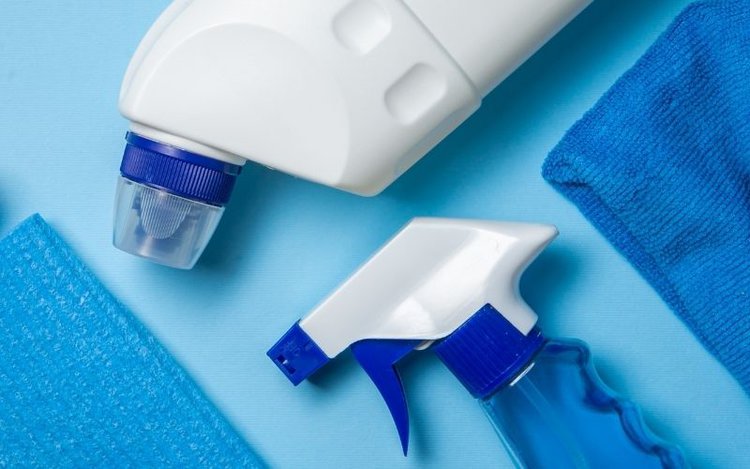
If your projector screen is devoid of dirt spots and the goal is to give the screen a quick wash as part of its maintenance routine, splashing some plain water and wiping off the screen with a microfiber cloth would do the job.
Use a soap or detergent only if there are apparent trouble areas or the screen has an overall unkempt appearance. To clear the pesky patches, follow the steps below:
- Pour some warm water in a bucket along with the mild soap or Formula 409 . The water to soap ratio should be 95:5.
- Once the soapy water is ready, take the microfiber cloth and dip it into it for a few seconds.
- Take out the wet cloth and squeeze it until the excess water is drained. Make sure the fabric is slightly damp and not completely drenched in water.
- Wipe the projector screen with a damp cloth, paying particular attention to the problematic regions.
- Use clean water to rinse off the wiped portions.
- Grab a dry, clean microfiber cloth and wipe off the rinsed areas.
If tiny spots are left behind, which do not warrant another round of holistic cleaning, spot-treat them with cotton swabs and denatured alcohol.
Here are the steps:
- Dip one end of the swab into the isopropyl alcohol and use it to clean the dirt spot. As you continue to treat the region with circular motions, the minor blemish should start to clear.
- Once the blemish is completely gone, use the dry end of the cotton swab to clean the spot so that there’s no alcohol residue left and no permanent stains develop.
Kindly note that a single dry swab end may not be enough to soak the alcohol.
Therefore, have one or two dry cotton swabs handy. You could also use a dry microfiber cloth wrapped onto your finger to rub off the area.
Things to Adhere to or Not Do When Cleaning a Projection Screen
- Falcon Dust-Off Aerosol Compressed Gas (152a) Disposable Cleaning Duster, 1-count, 3. 5 oz can The...
- Compact
- Indispensable for places where space is tight
(Paid Link.)
The best approach to cleaning a projector screen is not to touch the screen itself. In other words, compressed air should be your only cleaning tool if plausible.
Employ other cleaning tools/measures only if blowing canned air alone is not doing the job.
Besides, here are a few other things to keep in mind or be wary of when cleaning the screen:
- Do not scrub — just wipe. And do not apply excessive pressure, for the oils in the soap can battle the blemishes with relative aplomb.
- Do not use circular wiping movements as those movements may not fall in line with the projector screen’s design pattern. Some projector screen surface structures could be linear. Circular wiping motions could, therefore, be counterproductive or cause micro scratches. Gently wipe at right angles instead.
- If water runs or accumulates down the screen, soak them up with a dry microfiber cloth. Do not use a hairdryer or any air-drying tool as the heat produced by the machine could damage the screen.
- You could use a cleaning brush, provided its bristles are soft enough or won’t cause micro scratches. Abrasive scrubbing sponges should never be in tow.
If dealing with a custom-made screen, check with the installer or dealer before you get down to cleaning the screen. There could be special cleaning requirements you may not know and should strictly adhere to.
How Do You Clean an Inflatable Projector Screen?
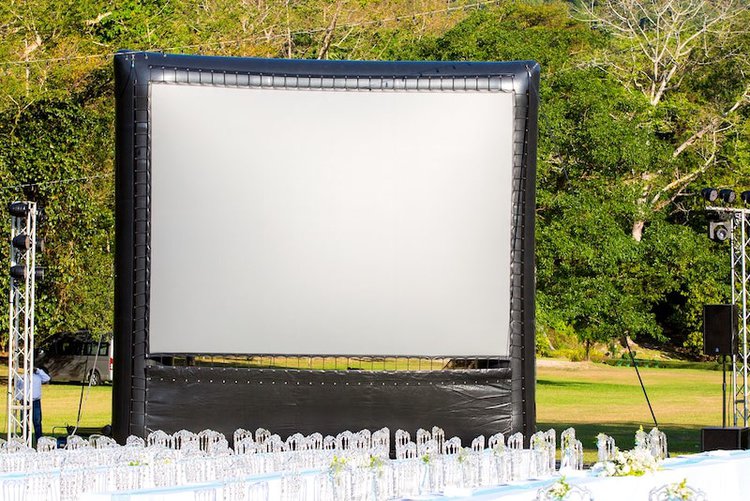
You can fill up an inflatable projector screen with an integrated air pump. Ideal for larger venues, inflatable screens are sturdy, resilient, and can put up with varied weather conditions.
Thanks to their ability to withstand the elements, you can clean inflatable screens a lot more effectively. You could even deflate and toss one into the washing machine. Using the washing machine, however, should strictly be the last resort.
In most cases, wiping the screen with a clean rag just before starting a projection would suffice. When that doesn’t help eliminate popcorn grease, dirty fingerprints, etc., resort to the cleaning measures mentioned above.
In case you’re curious how an inflatable projector screen works or even looks like when completely filled with air, watch this video:
Preventing Outdoor Projector Screens from Getting Dirty
Just because you can clean an outdoor projector screen doesn’t imply you can be reckless with it. As they say, “prevention is better than cure”. Ensure your projector screen doesn’t get dirty, to begin with, or minimize the likelihood of that.
Here are things you could do, to not have to deal with a dirty screen:
Do Not Keep the Screen “Outdoors”
As oxymoronic as it may sound, an outdoor screen is not meant to be stationed outside indefinitely. Once you’re done projecting, the screen must ideally head indoors.
When positioned outdoors permanently, the screen is at the mercy of nature and its elements — such as rain, snow, sun, wind, etc.
- A screen not appropriately installed could get robbed, or the wind could uproot and blow it away.
- The sun’s ultraviolet rays can degrade a permanently set up screen’s quality significantly, hampering your viewing experience.
- Water or moisture can hurt your projector screen, resulting in mold, mildew, and oxidation concerns.
The damages inflicted by the sun, rain, and wind put together would result in a projector screen that develops tears, wears down, or outright crumbles.
Move the Screen into the Shade
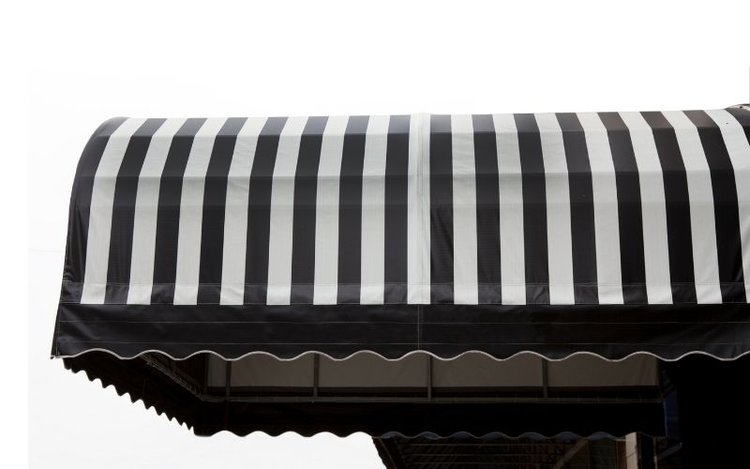
If taking your outdoor screen indoors is not feasible, ensure the screen is securely installed. In other words, screw it well, use robust cords, and the stakes must be firmly in place so that no breeze or wind can rattle the screen.
Most importantly, keep the screen in the shade — out of direct contact with the sun, rain, etc. Moving it under a canopy, to the patio, etc., are ways to safeguard the screen while still keeping it outside.
If you cannot immediately carry the projector screen inside, placing it in a semi-open area is a lot better than letting it stay entirely in the open.
Don’t Swaddle a Wet Screen
Retractable projector screens should be rolled out only during use. During other times, roll them up. But do not roll up the screen when it’s fresh from a wash. A wet screen is a recipe for mold and mildew.
If you cannot avoid rolling up a wet, moisture-laden screen, unbundle the wet screen as soon as you can do so. Let it dry. Repack the thing only when it’s completely dried out.
Conclusion
With age and use, projector screens can deteriorate and may not look as good as they did before — particularly the outdoorsy types. Therefore, it is critical to tend to them a lot more frequently or scan them every time after a projection session.
If you manage to detect issues on the screen’s surface, the above cleaning tools and tricks should come to your rescue. Even if there are no apparent concerns, routinely giving your outdoor projector screen a gentle wash would ensure splendid visuals for years to come.
Catherine Tramell has been covering technology as a freelance writer for over a decade. She has been writing for Pointer Clicker for over a year, further expanding her expertise as a tech columnist. Catherine likes spending time with her family and friends and her pastimes are reading books and news articles.



